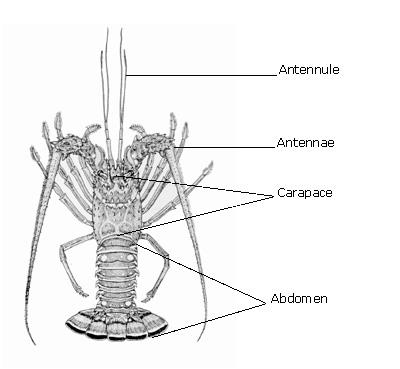Anatomy & Physiology
The ornate spiny lobster, unlike other lobsters, lacks big front claws and relies on spines covering majority of its body as its primary form of defence. Its front two antennae can grow up to 2 feet (61cm) long and are waved around to deter predators and can be also rubbed together to produce a loud grinding acoustic noise that warns predators and other lobsters to keep their distance. The antennules are much smaller than the antennae and also extend from the fused head. Together, the attenules and antennae are used to provide protection and assist in chemoreception of female sex pheromones and food sources (Pitcher et al. 1992c).

Image: (Above) Anatomy of Panulirus genus. (Redrawn from Pitcher et al. 1995)
Antennae: long and covered in setae (stiff hairs) used as smelling organs.
Carapace: Fused head and thorax.
Abdomen: Tail and tail-fan
The Panulirus genus consists of lobsters with 6 pairs of limbs with 5pairs of walking legs. The gender of the species can be determined by observing small swimmerets (feathery appendages on underside of tailfan) on female organisms. Males have only single or which have only single, or uniramous, pleopods while females have biramous pleopods. Females are also viewed to havea wider tail due to their egg bearing duties during reproduction (Pitcher et al. 1992c).
The Cephalothorax is encased dorsally and includes the fused head, thorax and abdomen. The Panulirus genus has compound eye stalks, similar to that of othercrustaceans. The mouthparts have many components including the mandibles, maxillaeand maxillipeds (Pitcher et al. 1992c).
The tail-fan is composed of heavily calcified uropods and the telson. The tail-fan is controlled by a powerful abdominal musculature which allows the lobster to utilise a tail-flip escape response when it feels threatened (George, 1968).
 
Images: (Above) The abdomen of the Panulirus ornatus
|